Physical Address
304 North Cardinal St.
Dorchester Center, MA 02124
Physical Address
304 North Cardinal St.
Dorchester Center, MA 02124
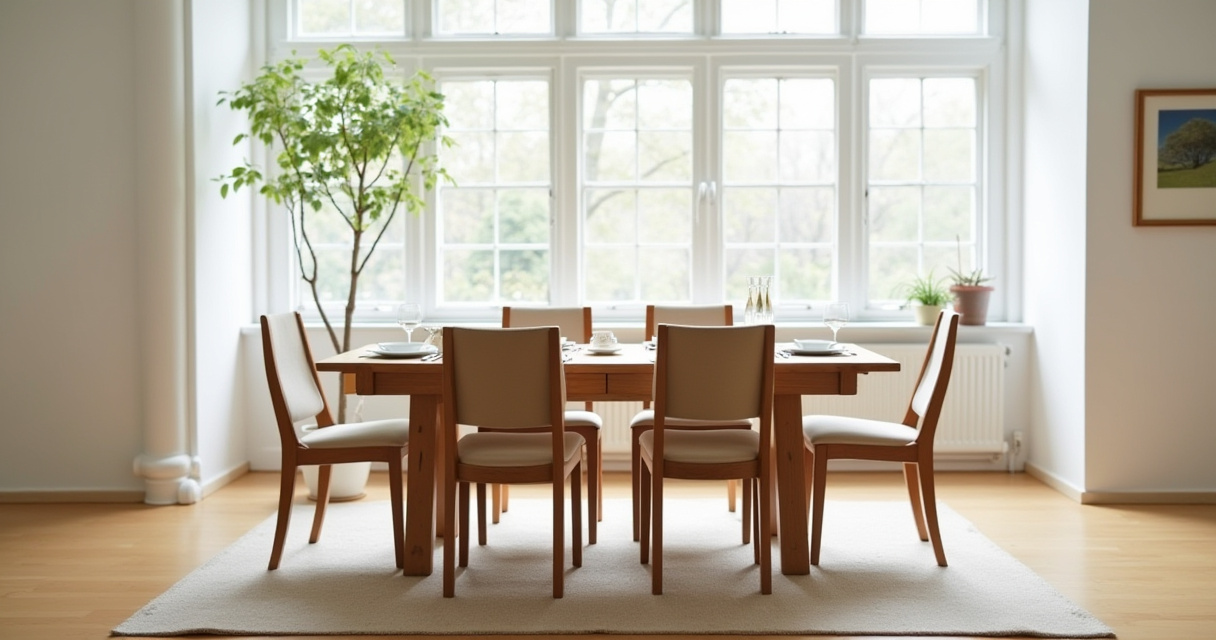
Transform your eating space with these 19 breathtaking dining room decoration ideas that blend function with beauty. From statement lighting to seasonal refreshes, create a dining space that nurtures both body and soul.
The dining room transcends mere functionality—it’s the heart of our homes where family stories unfold and friendships deepen over shared meals. In Islamic tradition, the act of gathering to break bread carries profound spiritual significance, creating a sacred space of connection and gratitude.
Yet many dining rooms remain overlooked, their potential for beauty and meaning unrealized. The space where we nourish both body and soul deserves thoughtful attention, reflecting not just our aesthetic preferences but our values of hospitality and community.
The dining table stands as the heart of your dining room decoration—a gathering point that silently witnesses life’s celebrations and everyday moments. Finding the right table requires careful consideration of both form and function. Measure your room dimensions and allow at least 36 inches of clearance around all sides for comfortable movement. For each person seated, allocate 24 inches of width to ensure everyone has ample space.

Consider how table shapes influence both aesthetics and interaction. Rectangular tables offer generous surface area for serving dishes, while round tables foster more intimate conversation by allowing everyone to see each other equally. Materials matter too—solid hardwoods like walnut or oak bring warmth and durability, while glass creates visual lightness in smaller spaces.
The inspiration for this collection struck when I visited a client’s home where an antique wooden table, worn smooth by generations of family meals, became the natural center of every gathering—even when no food was present. The right table doesn’t just serve meals; it creates a gravitational pull that draws people together.
Dining chairs bridge the crucial gap between comfort and style, determining whether guests linger over conversation or rush to leave after meals. When selecting chairs, prioritize ergonomics—seat heights between 18-20 inches from the floor, adequate depth behind the knees, and supportive backs that encourage proper posture during longer gatherings.
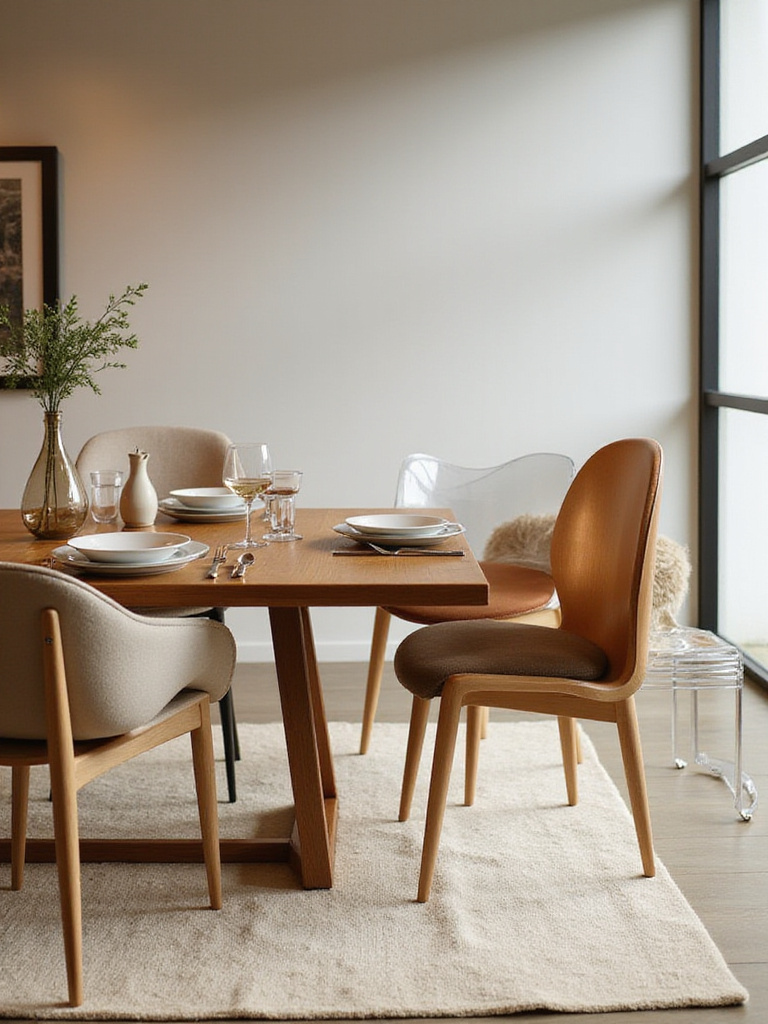
The chair material speaks volumes about your dining room decoration philosophy. Upholstered options with performance fabrics offer luxurious comfort while withstanding inevitable spills. Wood provides timeless appeal with easier cleaning, while mixed materials—metal frames with leather seats or woven elements—add contemporary edge. Don’t overlook the power of mixing chair styles strategically, perhaps using statement armchairs at the table ends with simpler side chairs along the length.
What makes this design special is the way different chair styles can create visual rhythm while maintaining harmony. Consider chairs as jewelry for your dining space—they should complement rather than compete with your table while expressing your unique aesthetic voice.
Lighting transforms dining room decoration from merely pleasant to truly transcendent, creating atmosphere that elevates every meal. The most successful dining rooms incorporate three distinct lighting layers: ambient illumination for overall brightness, focused task lighting for serving areas, and accent lighting to highlight architectural features or artwork. This thoughtful layering creates depth and allows the mood to shift from bright family breakfasts to intimate evening gatherings.
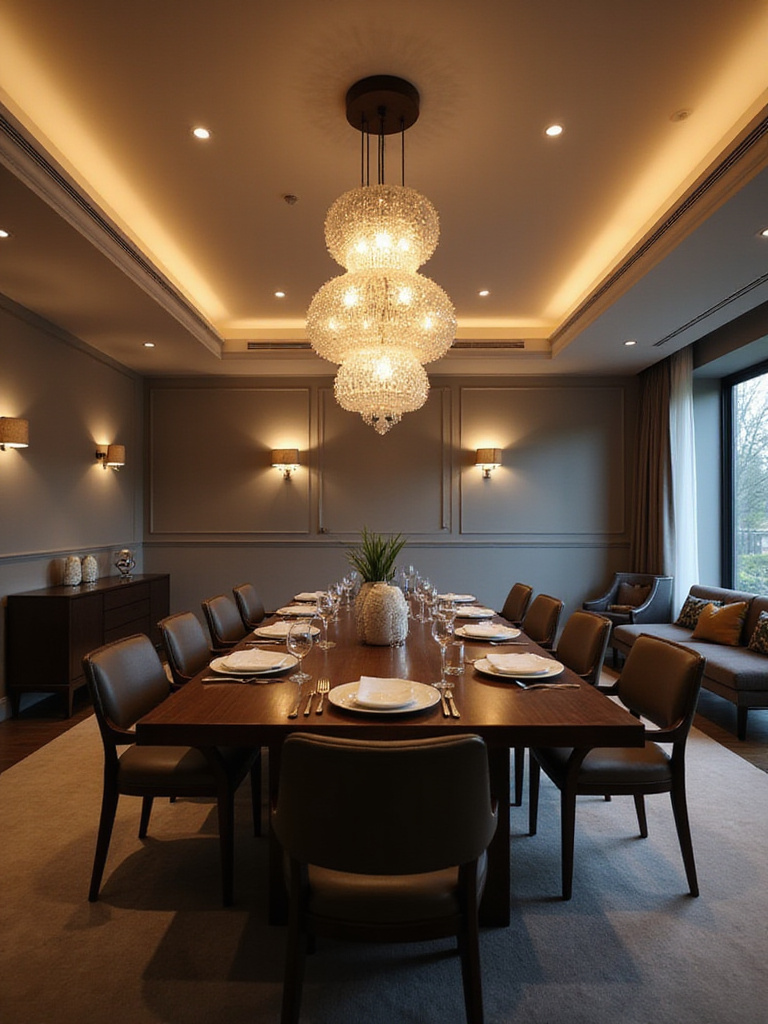
The chandelier or pendant above your table serves as both functional light source and sculptural statement. Size matters significantly—a fixture approximately one-third the width of your table creates proper proportion. For standard 8-foot ceilings, hang pendants 30-34 inches above the table surface; for higher ceilings, add 3 inches for each additional foot of height. Consider dimmable fixtures with warm-toned LEDs (2700-3000K) that flatter both food and faces.
The magic of this piece lies in its ability to cast gentle pools of light that create intimate dining zones even within larger spaces. In Islamic design tradition, lighting fixtures often incorporate geometric patterns that cast mesmerizing shadows, transforming simple walls into canvases of sacred geometry as evening falls.
A thoughtfully chosen rug anchors your dining room decoration, visually defining the space while adding warmth, texture and acoustic benefits. More than mere floor covering, the right rug creates a sense of intention and completion that elevates the entire room. In open-concept homes, a rug becomes particularly essential, establishing clear boundaries between dining and adjacent living areas.
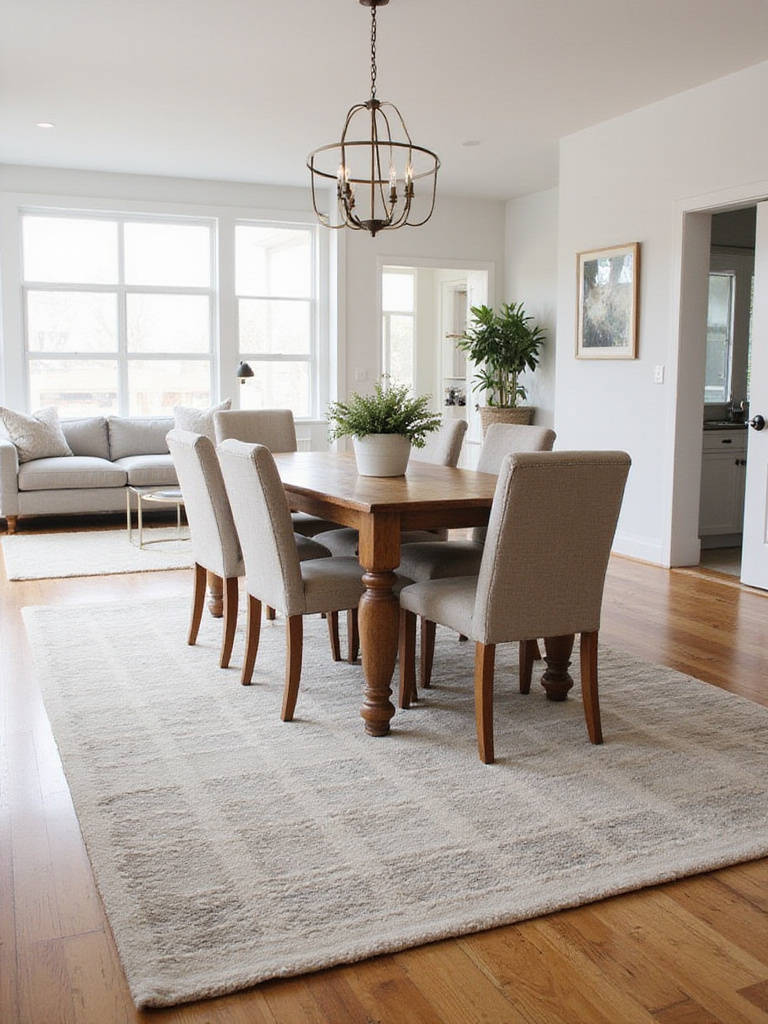
When selecting size, follow this crucial rule: your rug should extend at least 24-30 inches beyond all sides of the table when chairs are pulled out. This ensures chair legs remain on the rug even when occupied, preventing wobbling and floor damage. For material, prioritize durability and stain resistance—wool blends offer natural resilience, while synthetic options like polypropylene provide excellent value and cleanability for busy households.
Unlike mass-produced alternatives, this technique allows the rug to become a foundational element rather than an afterthought. Consider geometric patterns that reference traditional Islamic tessellations—these timeless designs bring mathematical harmony to your space while accommodating inevitable spills with their pattern complexity.
The vertical surfaces of your dining room offer canvas space for personal expression within your dining room decoration scheme. Thoughtfully chosen wall elements create visual interest, reflect your aesthetic sensibilities, and stimulate conversation among guests. Empty walls leave a room feeling unfinished, while thoughtfully adorned ones complete the design narrative.
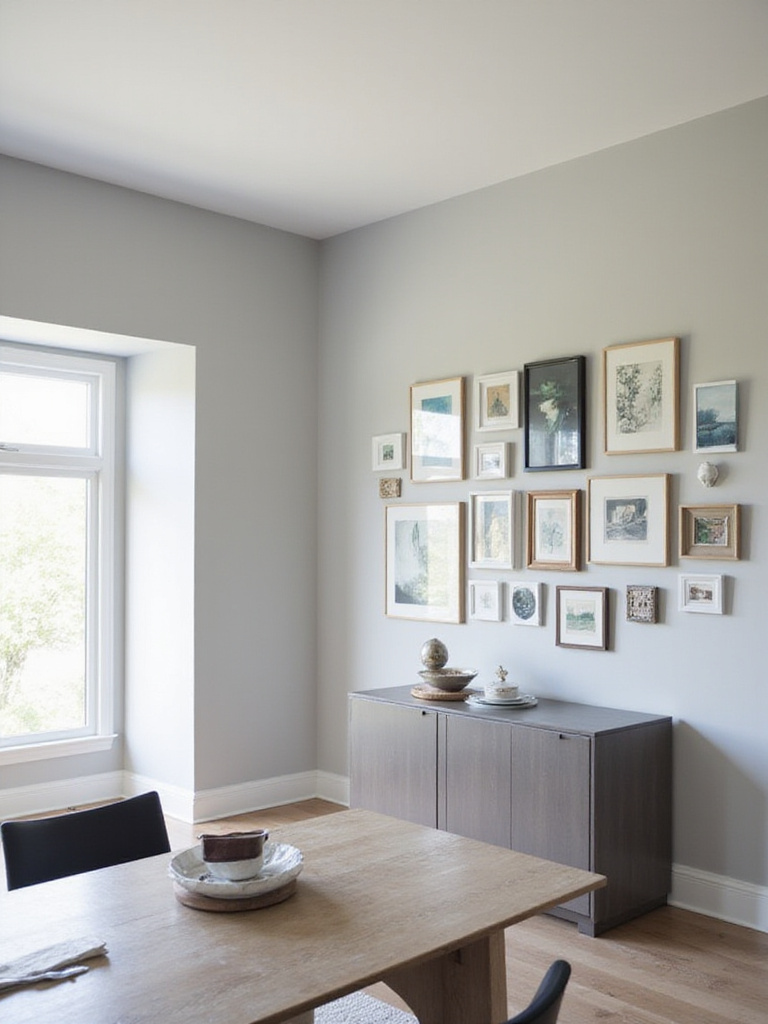
Consider these impactful options for dining room walls:
The designer’s secret here is to select pieces that resonate with you personally while considering appropriate scale. Art hung at eye level (approximately 57-60 inches from the floor to the center) creates proper visual balance. In dining spaces, consider subject matter that enhances appetite rather than diminishes it—food-related themes, landscapes, or abstract works in warm tones complement the dining experience.
The centerpiece crowns your table, establishing mood and expressing seasonal awareness within your dining room decoration. An effective centerpiece creates visual interest without obstructing conversation—aim for arrangements low enough (under 12 inches) or narrow enough that diners can see each other comfortably across the table.
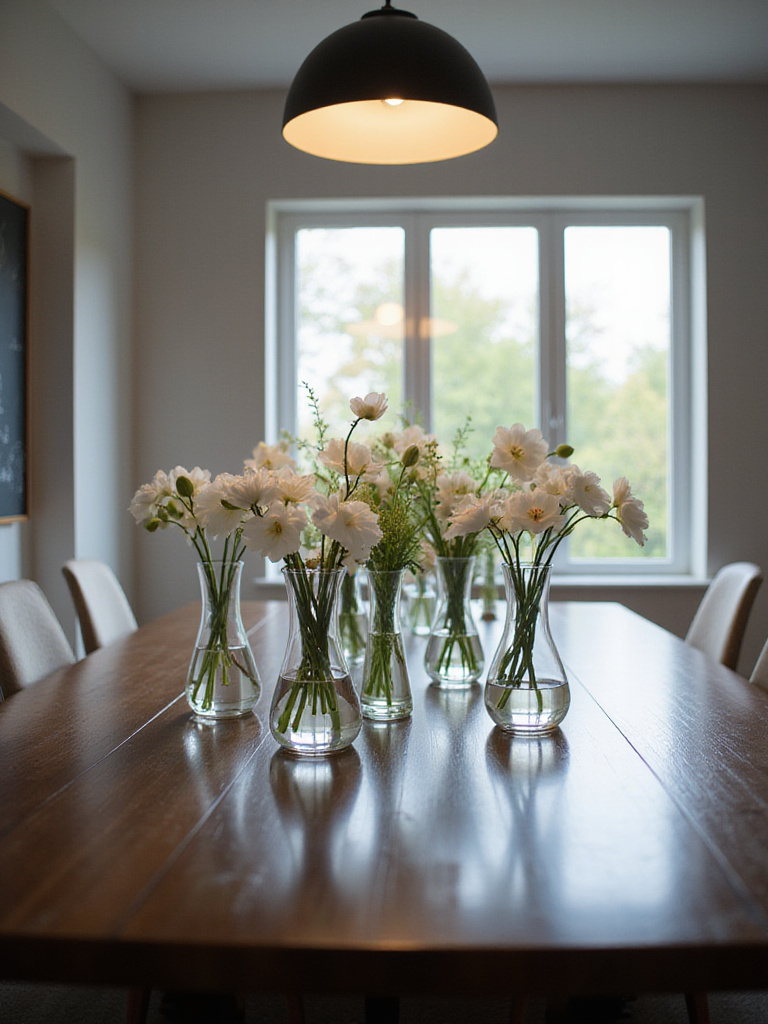
Consider centerpieces that engage multiple senses:
The artisan collective that creates these pieces often draws inspiration from sacred geometry, incorporating patterns that have adorned Islamic architecture for centuries. Consider centerpieces that can evolve throughout the season, perhaps beginning with flowering branches in spring that give way to lush summer blooms, autumn fruits, and winter evergreens.
A sideboard or buffet provides essential storage while significantly enhancing your dining room decoration strategy. This multifunctional piece keeps tableware, linens, and serving pieces accessible yet organized, reducing clutter and creating a more serene dining environment. The horizontal surface offers valuable serving space during meals and display opportunities between gatherings.
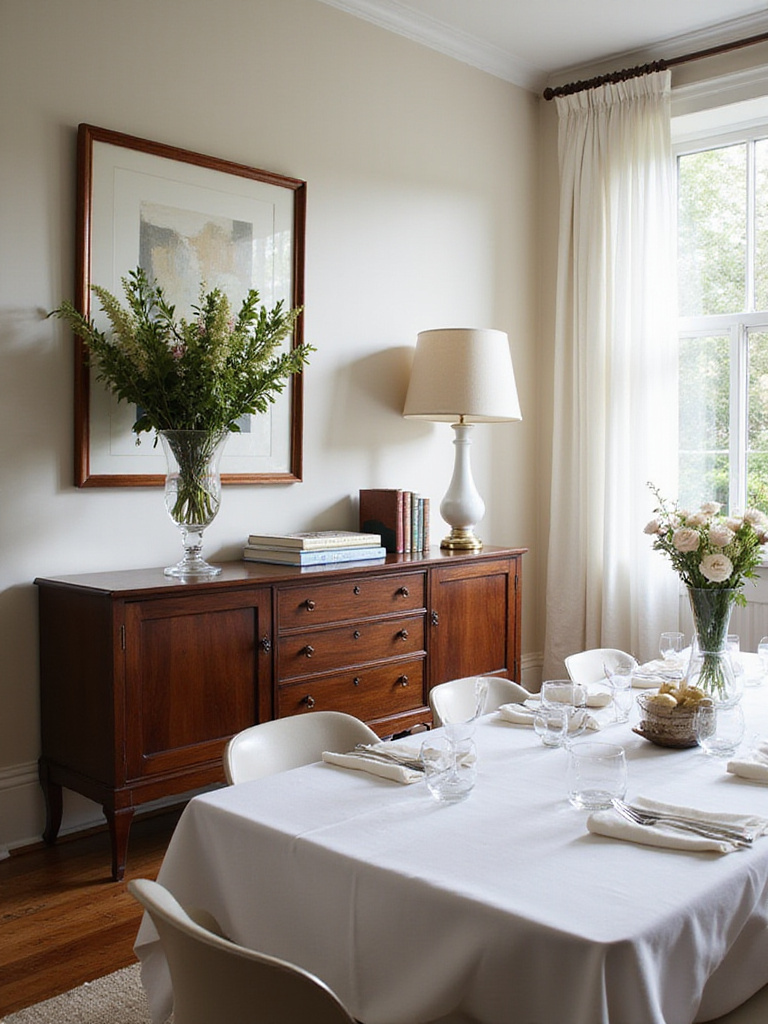
When selecting the perfect piece, consider both practical and aesthetic factors. Ensure adequate clearance—at least 36 inches between the buffet and table/chairs when occupied. Look for interior features like adjustable shelves, drawers with dividers, and specialized storage for linens or silver. Stylistically, your buffet can either complement your table for cohesion or contrast thoughtfully for visual interest. Materials should withstand dining room conditions—sealed surfaces resist moisture and heat from serving dishes.
For those worried about maintenance… consider pieces with slightly distressed finishes that gracefully accommodate the inevitable nicks of daily life. In Islamic design philosophy, beauty emerges from utility—choose storage pieces that function effortlessly while contributing visual harmony to your dining room decoration.
Color profoundly influences dining room decoration, shaping both atmosphere and appetite through subtle psychological effects. The palette you choose establishes immediate emotional tone—warm hues like terracotta, saffron, and cinnamon stimulate conversation and create welcoming energy, while cooler tones like sage, teal, and indigo impart calm sophistication.

Consider your dining habits when selecting colors. For lively family meals and frequent entertaining, warmer hues encourage lingering and conversation. For more formal or meditative dining experiences, cooler or neutral palettes create elegant restraint. Remember that color appears in more than just wall paint—textiles, artwork, dishware, and natural elements all contribute to the overall color story of your dining space.
The interplay between the colors creates a sensory experience that enhances not just the visual dimension of dining but the taste experience itself. In Islamic color tradition, deep blues represent spiritual connection, while earthy reds and ochres ground the space in natural elements—a thoughtful balance perfect for dining room decoration that nourishes both body and soul.
Window treatments serve dual purposes in dining room decoration—controlling light and privacy while adding textural softness to balance the hard surfaces of tables and chairs. The right treatments frame exterior views like living artwork, creating visual anchors that complete your design narrative.

Consider both the practical and aesthetic aspects when selecting window coverings. For western-facing dining rooms, treatments that filter harsh afternoon sun prevent uncomfortable glare during evening meals. Southern exposures benefit from adjustable options that maximize winter light while minimizing summer heat gain. Materials should complement your overall design scheme—natural fibers like linen, cotton, and silk bring organic texture, while contemporary spaces might incorporate sleek roller shades or minimalist blinds.
When clients ask us about balancing style with comfort… we often recommend layered window treatments that offer maximum flexibility. Combining sheer panels for daytime diffusion with more substantial side panels or Roman shades for evening privacy creates dining room decoration that adapts to changing needs throughout the day.
Mirrors work subtle magic in dining room decoration, visually expanding space while amplifying natural and artificial light. Beyond mere reflection, well-placed mirrors create the illusion of architectural features where none exist and establish dynamic visual rhythm that enlivens static walls.
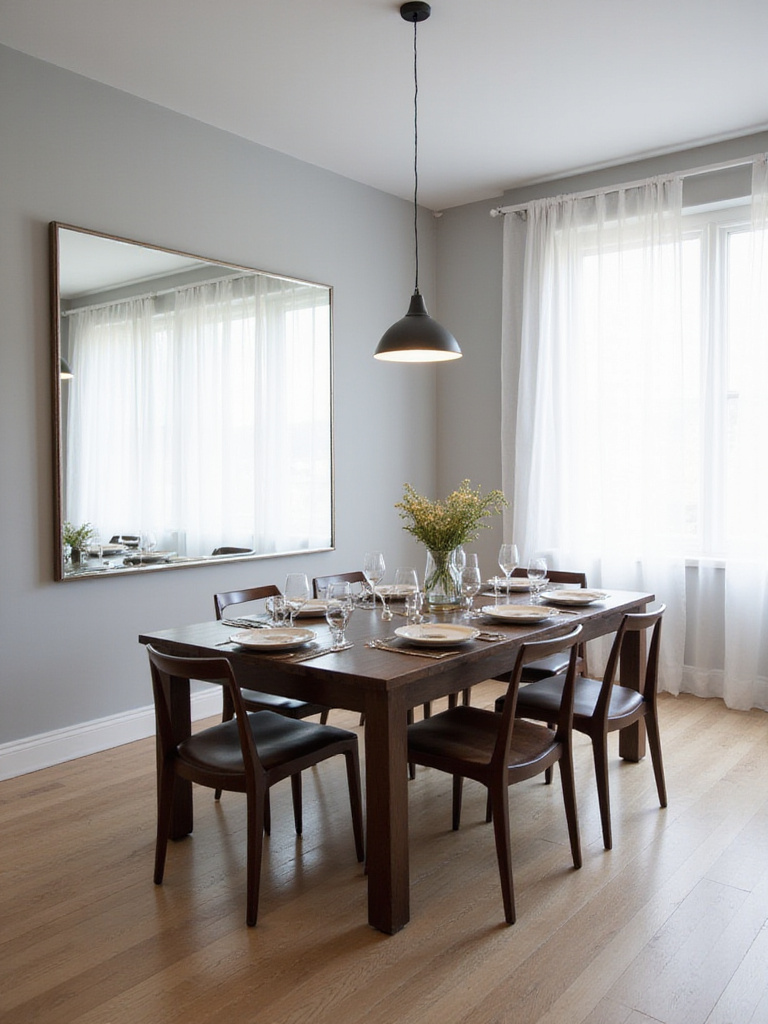
For maximum impact, position mirrors to reflect something beautiful—a chandelier, window view, or striking artwork. Avoid placements that reflect less appealing elements like kitchen work areas or storage spaces. Consider scale carefully; oversized mirrors create dramatic impact in smaller dining rooms, while a collection of smaller mirrors can create artistic interest in larger spaces. Shape selection matters too—circular mirrors soften rooms dominated by rectangular furniture, while geometric forms with faceted edges reference Islamic design traditions.
The silhouette draws inspiration from traditional Islamic metalwork, where intricate geometric patterns create mesmerizing visual depth. Consider mirrors with subtle metal overlays or etched patterns that add decorative interest even when viewed from angles where reflection is minimal—these details elevate dining room decoration beyond the ordinary.
Living plants infuse dining room decoration with vitality and connection to natural cycles. Beyond aesthetic beauty, plants improve air quality by filtering toxins and releasing oxygen, creating healthier indoor environments for gathering around food. Their organic shapes and varied textures soften architectural lines while introducing biophilic elements that reduce stress and enhance wellbeing.
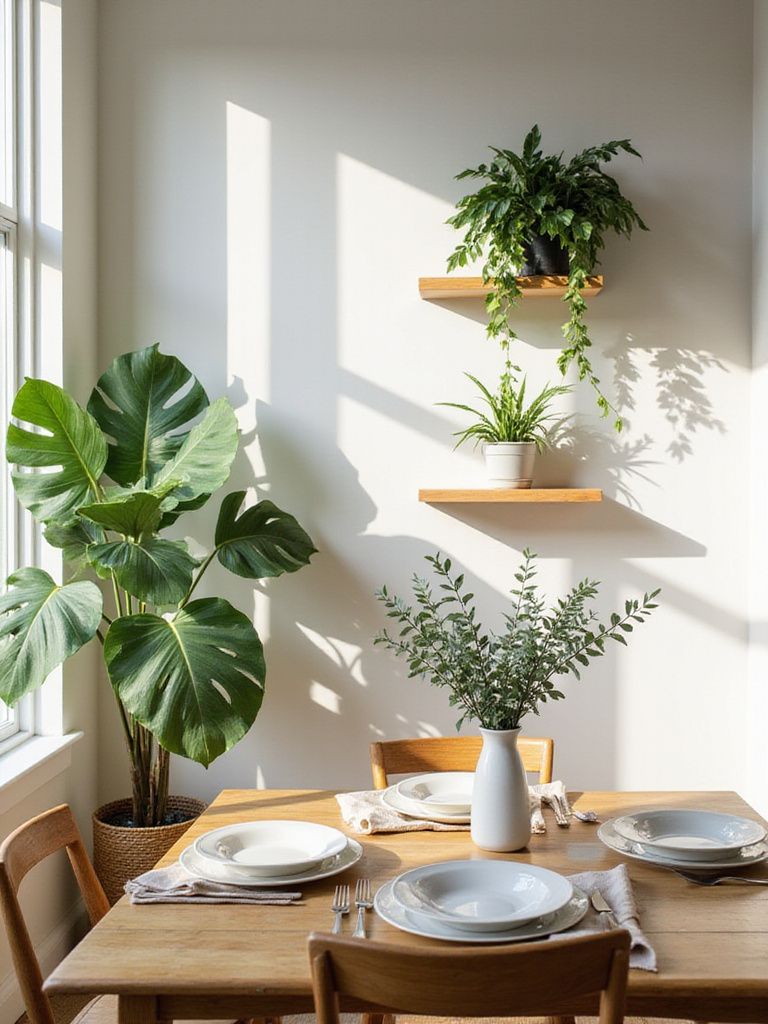
Select plants suited to your dining room’s specific light conditions and your maintenance capacity. For low-light spaces, consider resilient options like ZZ plants, snake plants, or pothos varieties. In brighter dining rooms, fiddle leaf figs, olive trees, or citrus plants thrive while making stronger visual statements. Consider scale carefully—larger floor plants anchor empty corners, while smaller specimens grouped on sideboards or as table centerpieces create more intimate natural moments.
The environmental story behind this piece began with traditional Islamic garden design, where plants represented paradise on earth. Even modest plant additions to dining room decoration can reference this heritage, creating moments of natural beauty that remind us of our connection to the created world as we gather to share its bounty.
Beautiful tableware deserves visibility beyond mealtimes, becoming decorative elements within thoughtful dining room decoration. Displaying cherished ceramics, glassware, and textiles transforms functional items into artful expressions of personal style while keeping frequently used pieces accessible.
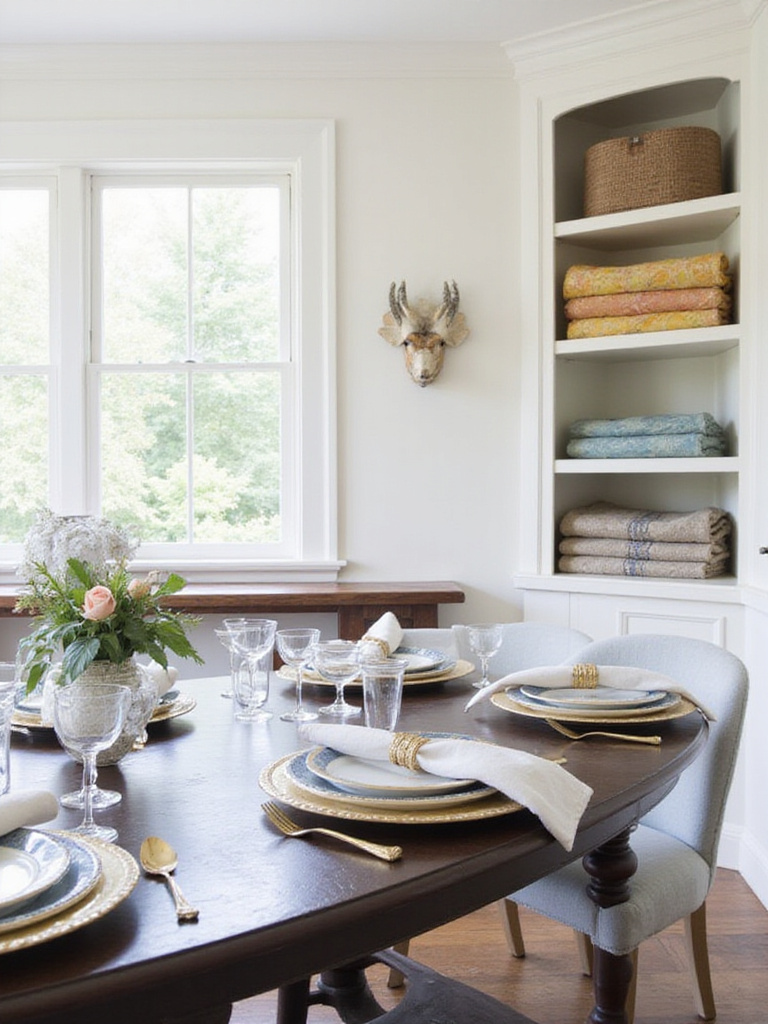
Consider these display approaches for dining elements:
The craftsmanship reveals itself in details like hand-painted ceramics or intricately woven textiles, each telling stories of cultural heritage and artisanal tradition. In Islamic dining culture, beautiful vessels honor both the food they contain and the guests they serve—this philosophy can inform contemporary dining room decoration that elevates everyday objects to artistic prominence.
Every successful dining room decoration scheme benefits from a clearly defined focal point that anchors the visual experience and creates immediate impact. This dominant element establishes the room’s character while providing a natural starting point for the design narrative that unfolds throughout the space.
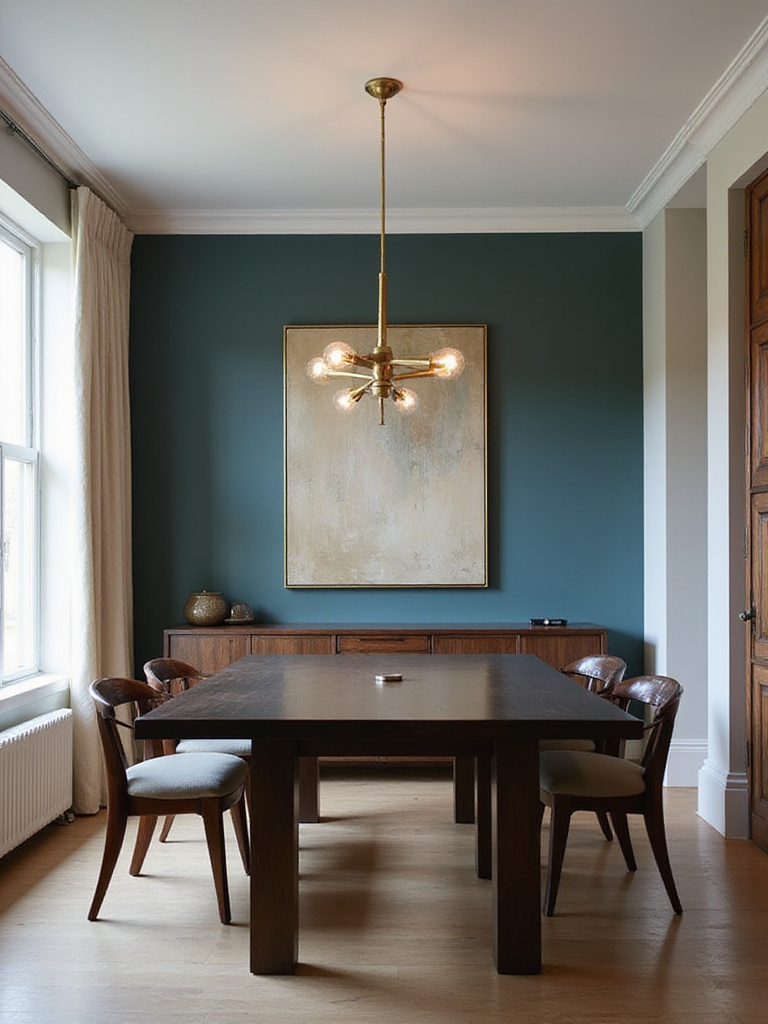
Potential focal points include architectural features like fireplaces or distinctive windows, statement lighting fixtures, dramatic wall treatments, or significant artwork. The key is singularity—one dominant element should claim primary attention, with secondary features playing supporting roles. Scale matters tremendously; undersized elements fail to command attention, while oversized ones can overwhelm the space. Position your focal point where it’s visible immediately upon entering the room for maximum impact.
Running your hand across this material reveals subtle textural variations that reward closer inspection. Consider focal elements that incorporate traditional Islamic design principles like geometric patterns, calligraphy, or arabesque motifs—these timeless elements bring mathematical harmony and spiritual significance to dining room decoration while creating distinctive visual interest.
Texture brings essential depth to dining room decoration, creating visual and tactile interest that flat color alone cannot achieve. Thoughtfully layered textures transform one-dimensional spaces into rich, multisensory environments that invite touch and create warmth even in minimalist settings.
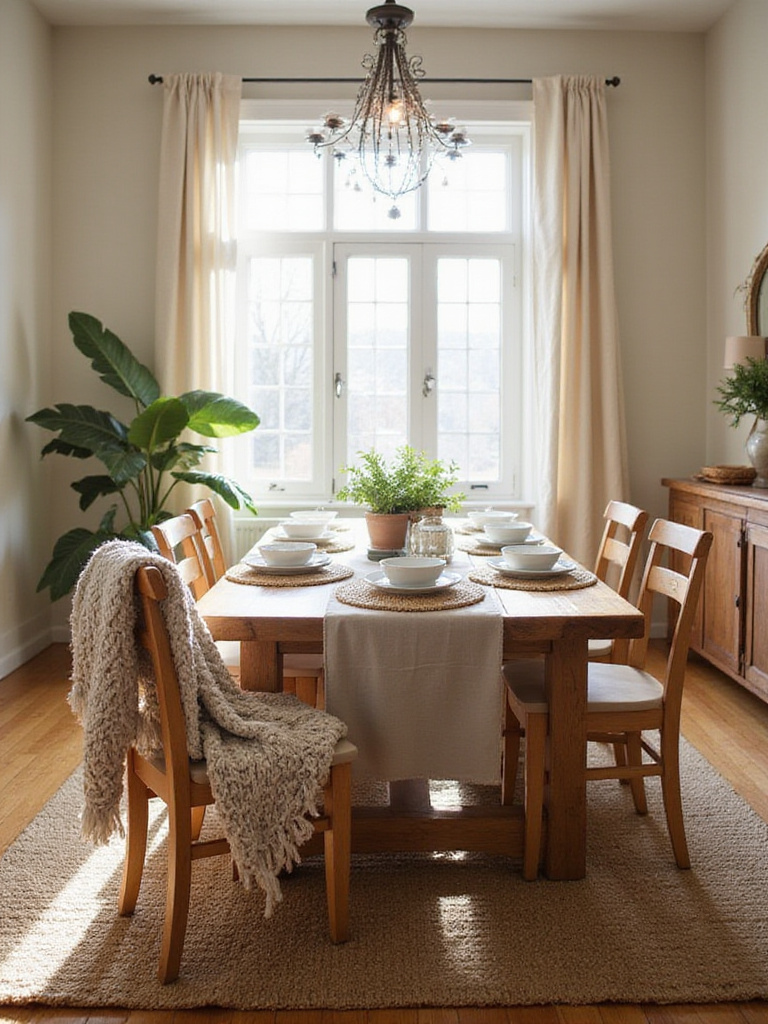
Incorporate texture through these elements:
The unexpected environmental benefit comes from how these natural textures absorb sound, reducing the echo that often plagues dining spaces with hard surfaces. In Islamic design tradition, texture creates subtle shadow play that changes throughout the day, bringing dining room decoration to life as light conditions evolve from morning to evening.
Architectural details like molding and trim transform ordinary walls into distinctive features within your dining room decoration scheme. These elements add visual structure, historical reference, and sophisticated detailing that elevates even the most basic spaces into more refined environments.
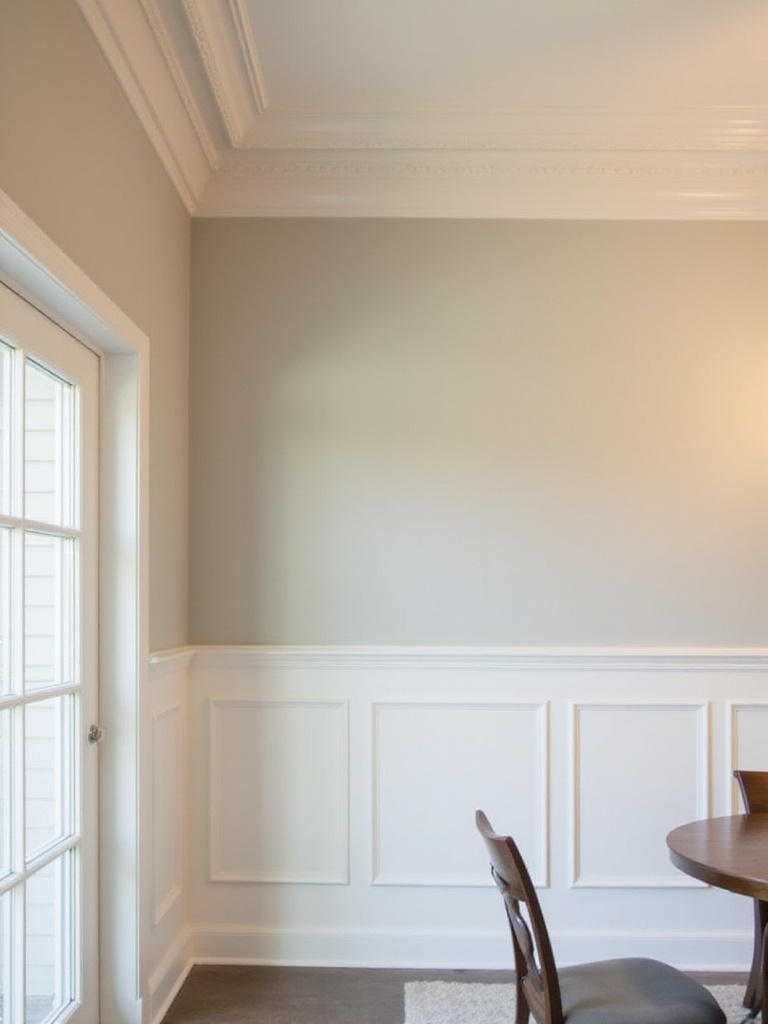
Consider various molding types for different effects: crown molding creates elegant transitions between walls and ceilings; chair rails protect walls while dividing vertical space; picture rails provide flexible display options; and wainscoting adds textural interest while protecting lower walls from chair damage. Scale these elements appropriately to your ceiling height—taller ceilings can accommodate more substantial moldings, while lower ceilings require more delicate profiles to avoid overwhelming the space.
The heritage technique gets a contemporary update through simplified profiles that reference traditional patterns while maintaining clean lines suitable for modern dining room decoration. Consider geometric patterns inspired by Islamic design traditions—these timeless motifs bring mathematical harmony to walls while creating distinctive architectural character.
Thoughtfully arranged collections transform dining room decoration from generic to deeply personal, telling stories of your travels, interests, and heritage. Open shelving and display cabinets create opportunities to showcase meaningful objects while adding visual interest to vertical surfaces that might otherwise remain underutilized.
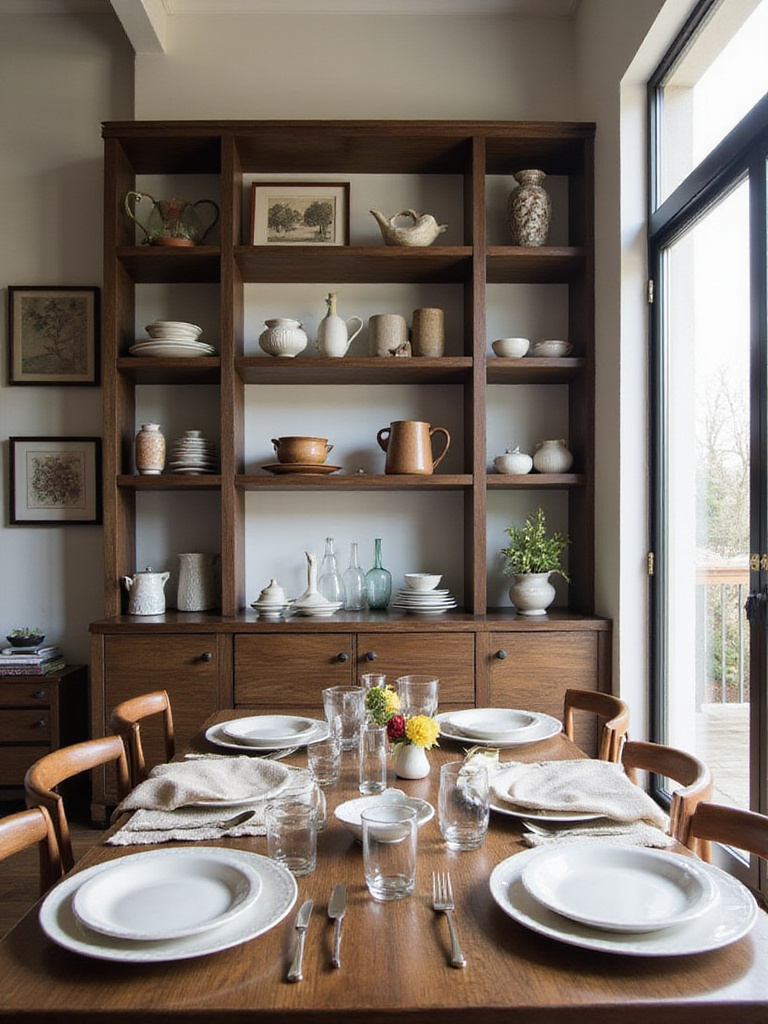
The key to successful display lies in curation—select items with intention rather than displaying everything you own. Group objects by color, material, or theme to create visual coherence. Vary heights and shapes while maintaining adequate negative space around groupings. Consider seasonal rotation to keep displays fresh and relevant to current dining experiences.
The cultural heritage preserved in each piece includes traditional craft techniques passed through generations. In Islamic design philosophy, even utilitarian objects deserve beauty—consider displaying handcrafted ceramics, metalwork, or textiles that bring cultural richness to your dining room decoration while sparking meaningful conversation among guests.
A well-styled bar cart introduces both functionality and sophisticated charm to dining room decoration. This mobile entertaining station keeps beverages and serving accessories organized and accessible while creating a dedicated zone for pre-dinner drinks or after-dinner digestifs.
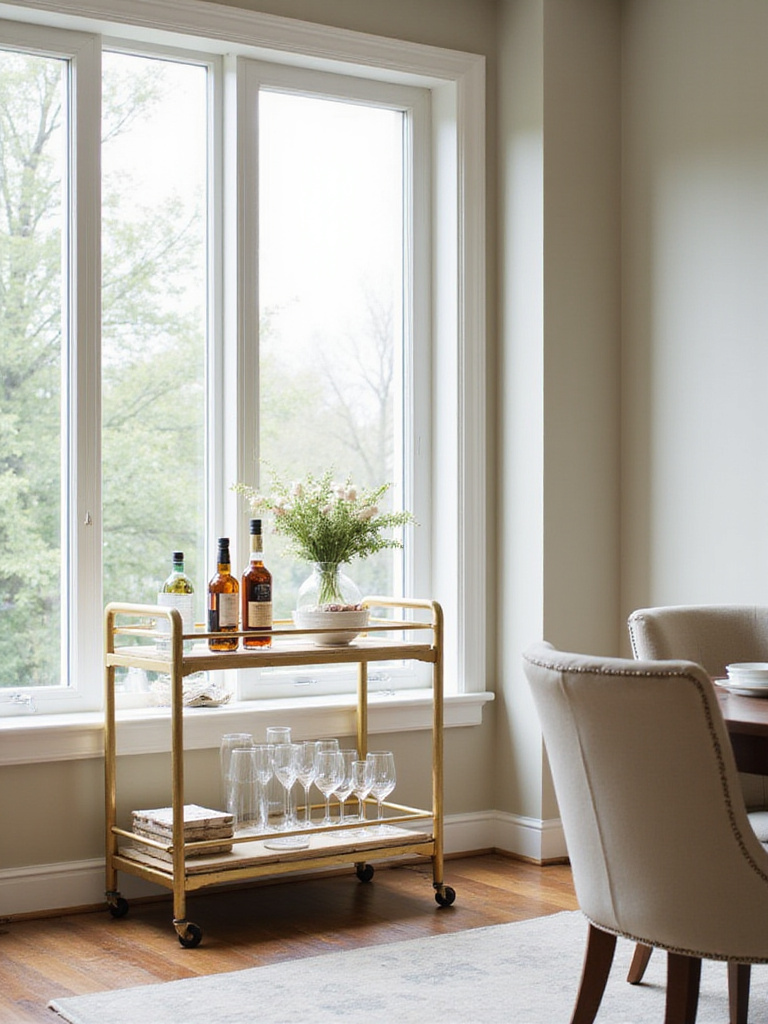
When selecting and styling your bar cart, consider both practical and aesthetic elements. Choose a size proportionate to your space—oversized carts can overwhelm smaller dining rooms, while undersized ones may appear insignificant. Materials should complement your existing furniture while offering practical features like spill-resistant surfaces and adequate storage. Style the cart with intention, grouping items by function and creating visual harmony through thoughtful arrangement.
The revival of this classic form comes with a twist in contemporary dining room decoration, as today’s bar carts often serve multiple functions—transitioning from beverage service to dessert display or even plant stand as entertaining needs evolve throughout the day or season.
Breaking free from matching dining sets creates more dynamic and personalized dining room decoration. Thoughtfully mixed chair styles express individual personality while creating visual rhythm that enlivens the dining experience. This approach allows for gradual collection of quality pieces rather than one-time purchase of matched sets.

Successful chair mixing requires strategic cohesion—maintain consistent seat heights (typically 18″ from floor to seat) for comfortable dining, and identify unifying elements like color family, material palette, or silhouette characteristics. Consider using identical chairs for head positions with different but complementary styles along the sides. Alternatively, use one chair style in different finishes or upholstery colors for subtle variation.
For those hesitant about bold patterns… start with subtle variation in chair styles while maintaining consistent color palette. This approach brings textural interest to dining room decoration without overwhelming visual complexity, creating spaces that feel thoughtfully collected rather than mass-purchased.
Seasonal refreshes keep dining room decoration feeling vibrant and responsive to nature’s changing rhythms. These periodic updates prevent design stagnation while creating dining experiences that reflect current light conditions, available produce, and cultural celebrations throughout the year.
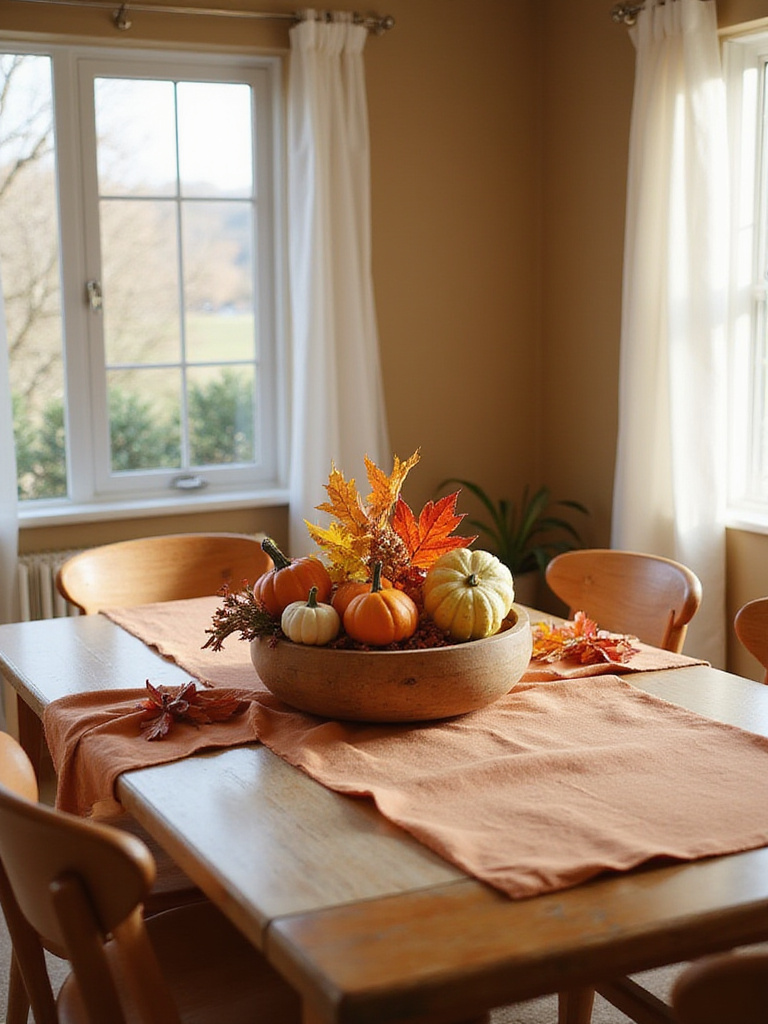
Implement these simple seasonal changes:
This season’s design language speaks to our innate connection with natural cycles. In Islamic tradition, seasonal awareness reflects divine order—incorporating this awareness into dining room decoration creates spaces that feel harmoniously aligned with the world beyond our walls.
The dining room stands as a sacred space where nourishment transcends the merely physical to feed our connections with one another. Through thoughtful dining room decoration that balances beauty with function, we create environments where conversations flow naturally, memories form effortlessly, and hospitality becomes an expression of our deepest values.
Whether you incorporate geometric patterns that reference Islamic design heritage or simply focus on creating a welcoming atmosphere through thoughtful details, remember that the most successful dining spaces reflect authentic personal style while honoring the fundamental human need for communion around shared tables. By implementing even a few of these nineteen ideas, you transform ordinary meals into opportunities for connection, turning your dining room into the heart of a home where everyone feels truly welcomed.